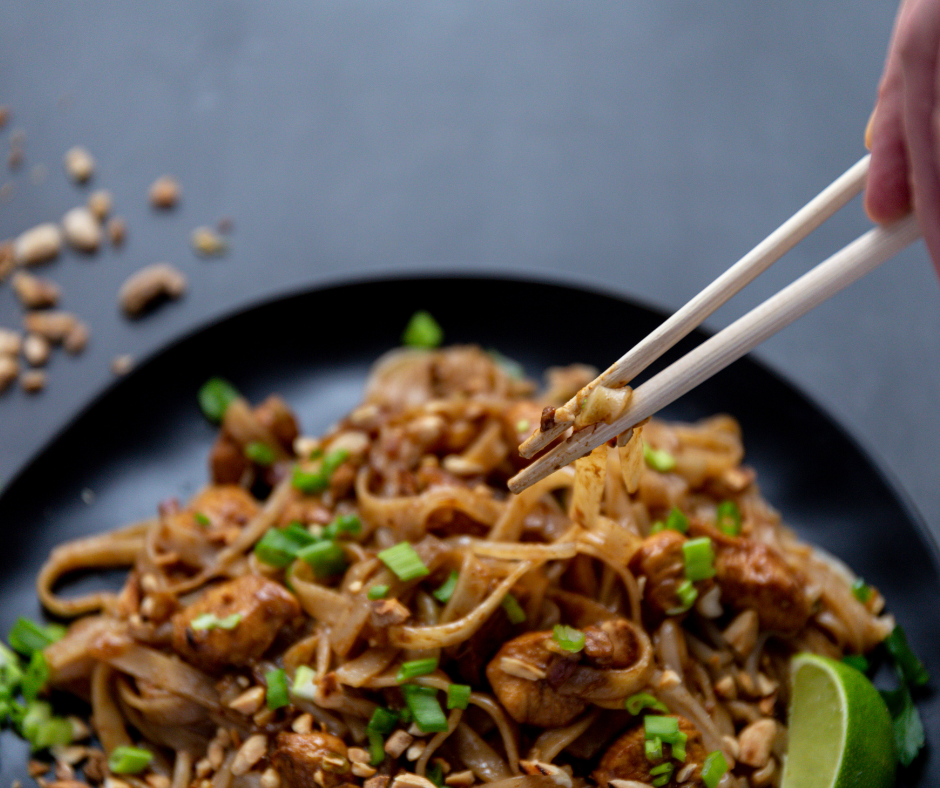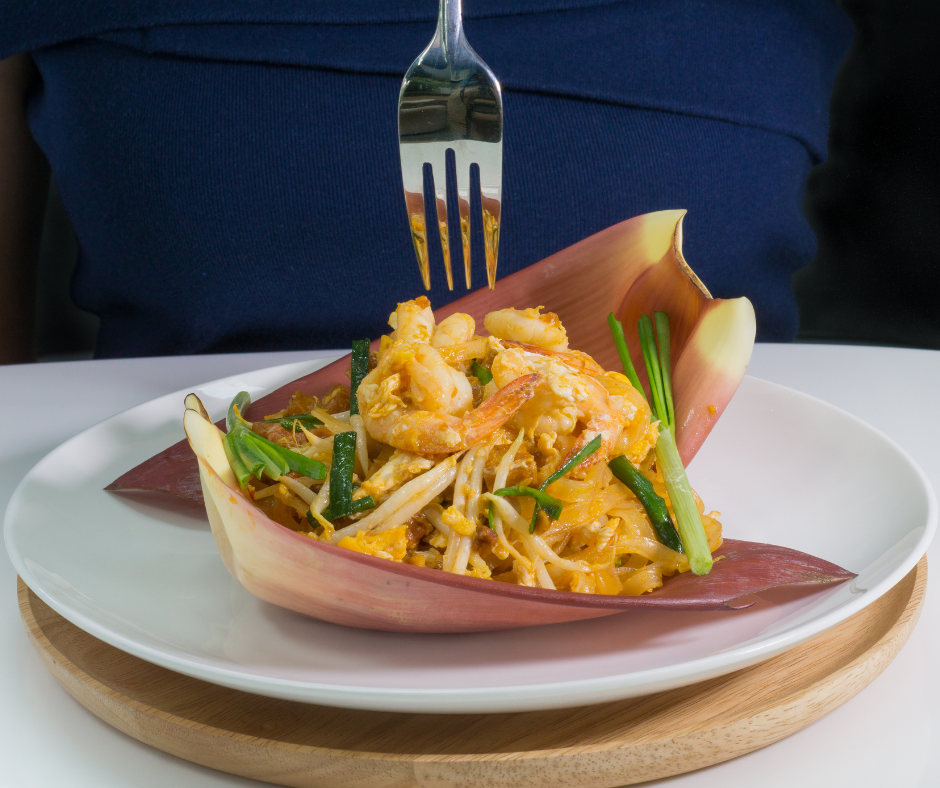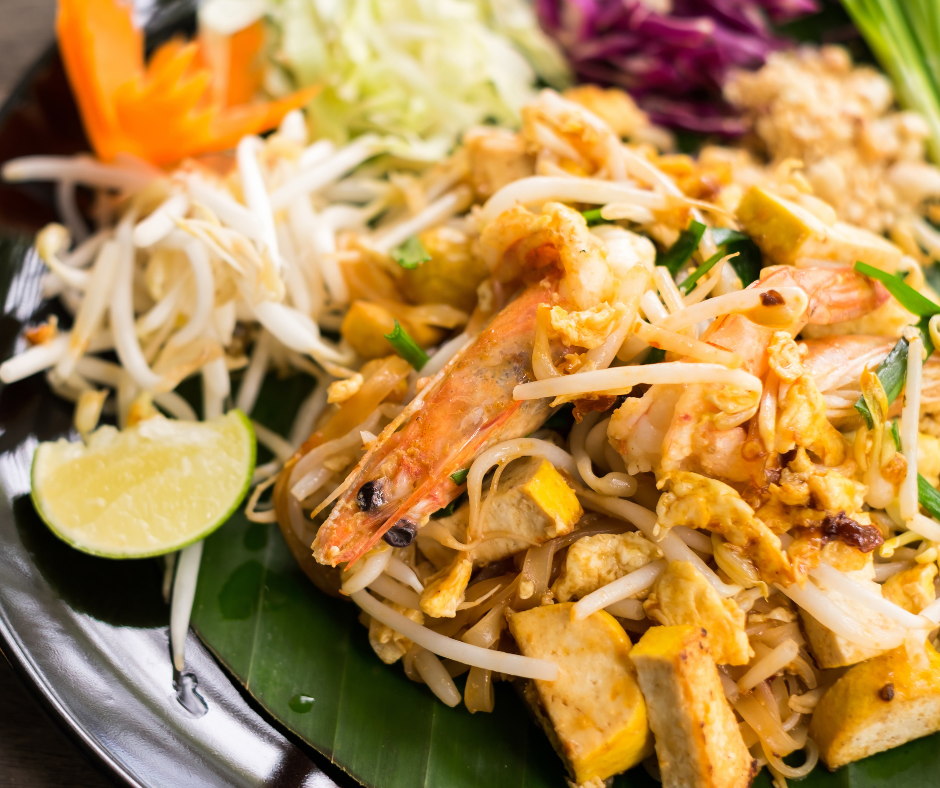Introduction
A Brief Overview Of Pad Thai And Its Popularity In Thailand And America
Pad Thai is one of the most popular Thai dishes around the world. However, it may be a surprise that it wasn’t even a part of Thailand’s culinary landscape until the 1930s. Since then, Pad Thai has become one of the most recognizable and beloved Thai dishes within Thailand and beyond.
While the Pad Thai Origin is difficult to trace, many believe that Chinese traders introduced the dish to Thailand, which evolved to reflect traditional Thai flavors. Others speculate that it is a dish of Vietnamese origin. Regardless of its origins, during World War II, when the country faced a severe rice shortage, rice noodles were not hard to find and presented a cheap and filling option. The noodles with vegetables and proteins, such as shrimp, provided a balanced, nutritious meal.
With the help of government initiatives, Thailand’s goal was to open thousands of Thai restaurants worldwide in 2001, and Pad Thai played a significant role in achieving this goal. The Thai government deliberately orchestrated Pad Thai to help propagate Thai cuisine as part of the country’s international branding strategy.
As a result, Pad Thai is now one of the most popular dishes in Thai cuisine worldwide, and its popularity continues to grow. In America, Pad Thai is among the top three dishes ordered in Thai restaurants, and it’s easy to see why. Its combination of sweet and savory flavors, plus the chewy texture of the noodles, makes it incredibly satisfying.
In conclusion, Pad Thai’s ascent to culinary fame has been short but storied. While it wasn’t originally a part of Thailand’s culinary scene, it has carved out a unique place as a beloved and iconic dish of Thai cuisine. Its popularity in Thailand and America can be attributed to its delicious taste and government initiatives to promote Thai cuisine worldwide.
Pad Thai Origin
A Historical Account Of How Pad Thai Came To Be Known In Thailand
Pad Thai is undeniably one of the most recognized Thai cuisines globally. Surprisingly, it wasn’t until the 1930s that the dish entered Thailand’s culinary scene. While the Pad Thai Origin remains unknown, the consensus is that Chinese traders introduced it to Thailand, and it further evolved to reflect traditional Thai flavors. Some people speculate that the dish has Vietnamese origins.
During World War II, Thailand faced rice shortages due to war and floods. As a result, rice noodles became a cheap and readily available alternative. The noodles, vegetables, and proteins, such as shrimp, make Pad Thai nutritious. The dish gained massive popularity in Thailand and became essential to the country’s cuisine.
In 2001, with government support, Thailand launched an initiative to encourage global restaurant chains to open thousands of Thai restaurants worldwide. Pad Thai was a strategic dish to promote the Thai brand and culture. Unsurprisingly, this fulfilled the mission, and Pad Thai became one of the most famous dishes globally, both within and outside of Thailand.
Pad Thai is among the most commonly ordered dishes in Thai restaurants in America. Its sweet and savory flavors, coupled with the chewy noodles, make it unbeatable. Pad Thai’s success can be attributed to its rich taste and consistent support from the Thai government’s international branding strategy to promote Thai cuisine worldwide.
In conclusion, Pad Thai has carved out a unique place for itself as a beloved and iconic cuisine of Thailand. Its popularity in Thailand and globally can be traced back to its delicious taste, nutritious value, and the government initiatives designed to promote Thai cuisine worldwide.
Disputed Claims
A Discussion On A Thai-American Food Writer’s Claim That The Chinese Immigrants Invented Pad Thai
While Pad Thai is widely recognized as a quintessential Thai dish, a Thai-American food writer, Jet Tila, challenged its authenticity by suggesting that Chinese immigrants in Thailand created it. Tila claimed that the dish’s name, kway teow pad thai, reflects its Chinese origins.
Despite Tila’s claims, other historians and experts disagree, arguing that Pad Thai’s evolution and incorporation of local ingredients and flavors prove its Thai origins. Some attribute the dish’s creation to Field Marshal Plaek Phibunsongkhram, a former Thai prime minister, who promoted Pad Thai as a national dish during World War II.
Furthermore, Pad Thai’s popularity and widespread recognition as a Thai dish cannot be denied, with the Thai government promoting it as a core component of its international branding strategy to showcase Thai cuisine to the world.
Whether or not Pad Thai was initially introduced by Chinese immigrants or created indigenously, its enduring popularity and position as a cornerstone of Thai cuisine cannot be disputed. As a result, it remains a staple menu item in Thai restaurants worldwide – a testament to its delectable taste and cultural significance.
Ingredients And Preparation
An Analysis Of The Ingredients And Cooking Technique Used To Make Pad Thai
Pad Thai is a dish that is commonly found in Thai restaurants around the world. It is a stir-fried noodle dish typically prepared with rice noodles, shrimp, eggs, bean sprouts, and other vegetables. The dish is topped with peanuts, cilantro, and lime wedges, providing a unique flavor profile.
To prepare Pad Thai, the ingredients are first stir-fried with seasonings such as tamarind, fish sauce, garlic, and palm sugar. The noodles are then added to the wok, shrimp, eggs, and vegetables and stir-fried until cooked.
One of the reasons why Pad Thai has become such a popular dish is because of its versatility. The dish can be easily modified to suit different dietary requirements and tastes. For example, vegetarians can substitute the shrimp and eggs with tofu and additional vegetables. The dish can also be made gluten-free with rice noodles and gluten-free sauces.
In addition to its taste and adaptability, Pad Thai is known for its nutritional value. The dish is low in fat and protein, making it an excellent choice for people looking to maintain a healthy diet. It is also a good source of essential vitamins and minerals such as vitamin C, iron, and potassium.
In conclusion, Pad Thai is a delicious and versatile dish that has become a staple in Thai cuisine worldwide. Its unique flavor profile, adaptability, and nutritional benefits make it a popular choice for people of all ages and dietary requirements.
Pad Thai During World War II
The Impact Of World War II On Pad Thai And How It Helped Make The Dish More Popular
Pad Thai was invented in 1938 in Thailand, but during World War II, the dish gained popularity. During this time, Thailand suffered from a rice shortage due to military action and floods. Phibun, the Prime Minister of Thailand, encouraged people to eat rice noodles instead. Promoting Pad Thai during World War II was a smart move, as it helped increase the dish’s popularity.
The proliferation of Pad Thai’s popularity continued after World War II. It became a common street food, sold in markets and small restaurants in Thailand. At the end of World War II, Pad Thai had become a solid part of Thailand’s national identity, and Thai immigrants began to spread the dish’s popularity worldwide.
Regarding ingredients and preparation, Pad Thai is generally prepared with rice noodles, shrimp, eggs, bean sprouts, and other vegetables, stir-fried in a wok with tamarind, fish sauce, garlic, and palm sugar. This dish’s versatility is one of the primary reasons for its popularity, as it can be easily modified to suit different dietary requirements and tastes. For example, vegetarians can substitute shrimp and eggs with tofu and additional vegetables. Similarly, the dish can be made gluten-free using rice noodles and gluten-free sauces.
Pad Thai is also known for its nutritional value. Being low in fat and high in protein, it is an excellent choice for people looking to maintain a healthy diet. It is also a good source of vitamins and minerals like C, iron, and potassium.
In conclusion, Pad Thai’s popularity has continued to grow over the years, helped by its versatility and nutritional value. The Pad Thai Origin during World War II in Thailand proves that it has become a beloved dish worldwide and remains a significant part of Thai cuisine.
Evolution Of Pad Thai
How Pad Thai Has Evolved And The Influence Of Globalization On Its Preparation
Pad Thai is a staple in Thai cuisine and one of the most popular dishes in Thai restaurants worldwide. It is a traditional Thai dish with stir-fried rice noodles, eggs, tofu, bean sprouts, and various spices, including tamarind, fish sauce, garlic, and palm sugar. The recipe for Pad Thai has evolved, and it is believed to have originated as a Chinese dish before being adapted by Thai chefs.
During World War II, Thailand suffered from a rice shortage due to military action and floods, which led to the promotion of Pad Thai by the Prime Minister of Thailand at the time, Phibun. The dish’s popularity surged, becoming a common street food sold in markets and small restaurants nationwide. After the war, Thai immigrants brought the dish’s popularity, spreading its fame worldwide.
In recent years, Pad Thai’s popularity has grown exponentially due to globalization. As the dish entered different cultures, the recipe began to adapt to meet the tastes of new audiences. For example, in Western countries, shrimp and eggs are more commonly used as ingredients, while in Thailand, the dish often includes dried shrimp and other seafood.
There are also variations of Pad Thai that cater to different dietary requirements, such as vegetarian and gluten-free options. These adaptations show the dish’s versatility and how it can still maintain its authenticity while accommodating different tastes and needs.
While Pad Thai has evolved, it remains essential to Thai cuisine and culture. Its nutritional value and ease of preparation have made it a beloved dish worldwide for its traditional roots and ability to adapt to changing tastes and cultures.
Regional Variations Of Pad Thai
Different Types Of Pad Thai Made In Different Regions Of Thailand And Their Unique Features
Pad Thai is a dish that has become synonymous with Thai cuisine worldwide. The dish has evolved, and its recipe has been adapted to meet the tastes of new audiences. However, regional variations of the dish retain their unique features and reflect the diversity of Thai cuisine.
In Bangkok, Pad Thai is typically made with prawns, chili flakes, roasted peanuts, and a generous squeeze of lime. The dish is sweet and sour, with a smoky flavor from the stir-fried noodles. It is often served with bean sprouts and Chinese chives, giving it a fresh and crunchy texture.
In the central region of Thailand, Pad Thai is made with tamarind paste, which gives it a distinctive tangy flavor. It is also served with lime wedges, but instead of chili flakes, it is garnished with dried chili flakes and roasted peanuts. It is typically served as a street food, with vendors frying the noodles on woks over charcoal.
In Northern Thailand, Pad Thai is made with fresh vegetables such as carrots, cabbage, and spinach. It is also often mixed with meat such as pork or chicken. The dish is less sweet and sour than the southern and central regions, and using fresh vegetables gives it a healthy and balanced flavor.
In Southern Thailand, Pad Thai is made with squid, shrimp, or crab. It has a spicy kick, with chili flakes and fish sauce dominating the flavor profile. The dish is served with lime wedges and roasted peanuts, and it is often eaten with seafood sauces to complement the flavor.
In conclusion, Pad Thai is a dish that has come to represent Thai cuisine worldwide. Its popularity has led to variations in its recipe, adapting to meet the tastes of new audiences. However, the regional variations of the dish retain their unique features and reflect the diversity of Thai cuisine. Each region’s Pad Thai has its special flavor, texture, and ingredients, making the dish an exciting culinary experience for all.
Popularity In America
How Pad Thai Became Popular In America And The Influence Of Thai Cuisine On American Dishes
Pad Thai, a dish that originated in Thailand, gained increasing popularity in the United States during the 1960s. Thai food consistently ranks among the top five most consumed and popular ethnic foods in the country. What makes Pad Thai the most popular of all Thai dishes could be attributed to its taste, ease of preparation, low cost, and high availability as street food.
The rise of Pad Thai’s popularity in America can be attributed to several factors. During World War II, American soldiers stationed in Thailand brought back a love for Thai food, and the dish became popular among American servicemen. Additionally, the influx of Thai immigrants to America in the 1960s helped to introduce the cuisine to a broader audience.
Pad Thai’s popularity in America also contributed to the creation of new dishes incorporating Thai flavors. Thai ingredients like lemongrass, cilantro, and coconut milk have become commonplace in many American kitchens. Thai-inspired dishes, such as peanut sauce or Thai-style curries, can be found in many American restaurants.
The influence of Thai cuisine on American dishes has also been seen in the rise of fusion cuisine. Chefs are now blending traditional Thai flavors with other international cuisines, creating unique and exciting new dishes popular with foodies and diners.
In conclusion, Pad Thai’s popularity in America can be attributed to the rise of Thai cuisine and the emergence of Thai flavors in American kitchens and restaurants. The dish has become a staple of Thai cuisine globally, and its unique regional variations offer exciting culinary experiences for all.
Conclusion
The Lasting Legacy Of Pad Thai And Its Continued Popularity Around The World
Now you should know about the Pad Thai Origin. Pad Thai’s popularity in America is just a small part of its global success. The dish has become a staple of Thai cuisine worldwide, and its unique regional variations offer exciting culinary experiences for all. Today, you can find Pad Thai in street vendors, restaurants, and home kitchens across the globe, cementing its lasting legacy as a popular comfort food loved by millions.
Pad Thai is a popular noodle dish from Thailand that has become a staple in Thai cuisine worldwide. The dish is characterized by stir-fried rice noodles, vegetables, herbs, bean sprouts, and peanuts, often topped with shrimp or tofu. While the exact origins of Pad Thai are unclear, historians believe it was invented in the 1930s or 1940s as part of a national effort to modernize Thailand and promote its independence. Initially, Pad Thai was associated with street food vendors and became a popular lunchtime snack among the working class. Today, Pad Thai is enjoyed by people worldwide who are looking to experience the flavors of Thailand’s iconic dish.



